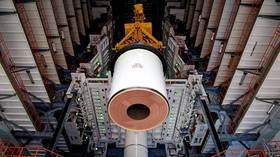India’s military research chief touts MORE ‘space deterrence’ weapons after satellite-killer test

The chief of India’s military research agency has announced plans to expand ‘deterrence’ capabilities in space, extolling prospective orbital and laser weapons, after its successful test of an anti-satellite missile last month.
“We are working on a number of technologies like directed-energy weapons (DEWs), lasers, electromagnetic pulse (EMP) and co-orbital weapons,” Chairman of the Defense Research and Development Organization (DRDO) Dr. Satheesh Reddy teased, at a press conference on Saturday.
Also on rt.com India caught between superpowers in ‘star wars’ arms race, says expert in space politicsStressing that India has achieved new “deterrence” capabilities matching those of US, Russia and China, he shared details and results of the “direct ascent, kinetic kill” anti-satellite test that India conducted on March 27.
In a mission dubbed Shakhti, which means ‘power’ in Hindi, the modified, three-stage ballistic missile defense interceptor was able to strike a Microsat-R satellite on a 283-kilometer orbit, Dr. Reddy said. If a need arises, he said, India can now target multiple enemy satellites, “including those for military use,” in low orbit of up to 1,000km, with multiple ground-launched missile interceptors.
Space has gained importance in the military domain. The best way to ensure security is to have deterrence.
The DRDO chief hinted that, with many prospective space weapon systems in development, the government might soon form an Aerospace Military Command.
Also on rt.com NASA attacks India’s ‘terrible’ space weapon test, but US is creator of much more space debrisFirmly brushing aside criticism that India’s satellite-killer test produced a lot of dangerous space debris and, according to US military and NASA, allegedly increased by 44 percent the chances of the International Space Station getting struck, Reddy stressed that India had approached the test with the utmost caution.
Some of the debris has already decayed. Our simulations show all debris will decay in 45 days.
“Low earth orbit was chosen based on simulations, with the primary objective being to minimize debris. It was intentionally done at 280km altitude so that debris decay fast,” Reddy explained, noting that there was no need for further tests as the system has proved fully functional.
Also on rt.com India joins space ‘super league’ as it shoots down satellite with precision missile – ModiLike this story? Share it with a friend!













